Robert Neumann, P&G Manufactring GmbH:"nach anfänglicher Skepsis bin ich sehr überzeugt von den Möglichkeiten der Software. Meine Erfahrung mit Simulations -Software im Speziellen ist dabei zwar recht beschränkt, jedoch bin ich der Meinung, dass extendsim zahllose Möglichkeiten
bietet und ich für unsere Zwecke (Simulation von Packing-Linien) mir nichts vorstellen kann, dass nicht möglich wäre. Vor allem das User Manual und die vielen Beispiele sind dabei sehr hilfreich!"

ExtendSim has always offered the best balance between ease-of-use, flexibility, and scalability from the simplest to the most complex systems. Now is no different. Imagine That Inc. developers put their heads together with ExtendSim users and what they came up with is tucked inside ExtendSim 9.
Imagine That Inc. added features with the future in mind...and that are tailored to the way you work so you can master complexity of any modeling challenge. Just check this list out!
November 2018: Meanwhile there is Version 10
(continue here for Version 9.2, which is still available on special request)
- As before, ExtendSim9 is still available in four license types (one stronger than the other) - see here
System and Hardware Requirements
![]() CPU:
CPU:
Since simulation is processor-intensive, we recommend that your computer have a powerful central processing unit (CPU).
Furthermore, as release 9 does not support multiple processors, fewer cores with faster processing speeds will execute simulations faster than more cores.
Windows specific:
![]() XP, Vista, Windows 7 or Windows 8
XP, Vista, Windows 7 or Windows 8
![]() 300 MB hard disk space (400 MB for ExtendSim Suite)
300 MB hard disk space (400 MB for ExtendSim Suite)
![]() 512 MB RAM (2 GB recommended)
512 MB RAM (2 GB recommended)
![]() For ExtendSim Suite: a 3D hardware accelerator card with 64+ MB RAM
For ExtendSim Suite: a 3D hardware accelerator card with 64+ MB RAM
Macintosh specific:
![]() OSX 10.4 to 10.6
OSX 10.4 to 10.6
![]() A browser to view the Help
A browser to view the Help
![]() 300 MB hard disk space
300 MB hard disk space
![]() 512 MB RAM (2 GB recommended)
512 MB RAM (2 GB recommended)
![]()
![]() Release 9 is not Lion compatible – it does not run on Mac OS 10.7 or greater.
Release 9 is not Lion compatible – it does not run on Mac OS 10.7 or greater.
New Features in Version 9
 New Statistics (DB) Report
New Statistics (DB) Report
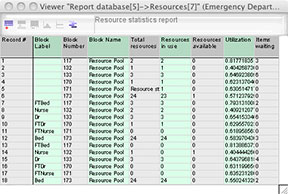 Statistics (DB) report contains final values for output parameters.
Statistics (DB) report contains final values for output parameters.
Statistical data from each simulation run is stored in an ExtendSim database, organized by block type so that there is one table per type of block. Blocks included in the report can be all blocks in the model or a user-defined subset of the blocks. Report tables can be exported to external databases or Excel when the simulation is complete.
Of course, ExtendSim's existing text-based reports have been maintained, but the new Statistics (DB) report provides better organization, presentation, and accessibility of model results.
This sample report shows resource usage in a healthcare model.
 ADO Database Support (Windows only)
ADO Database Support (Windows only)
Communicate with the most commonly used external databases. ActiveX Data Objects (ADO) provides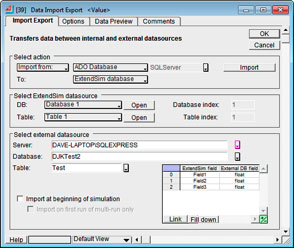 built-in import and export support for Microsoft Access, SQL Server, and MySQL. ADO sends an entire table of information at one time, providing high-speed data interchange.
built-in import and export support for Microsoft Access, SQL Server, and MySQL. ADO sends an entire table of information at one time, providing high-speed data interchange.
ADO is faster and easier to use than ODBC and it does not require defining a data source name (DSN) before accessing data. It automatically configures the ExtendSim database when importing and the external database when exporting. Plus mirrors fields and records between the source and its destination.
For example, here is the dialog of the Data Import/Export block configured for ADO Import from a SQLServer database into an ExtendSim database. The ADO interface is designed so that the modeler can access an ADO database by adding a Data Import/Export block to the model and selecting the internal and external data sources.
 Flow Attributes
Flow Attributes
Enhancing ExtendSim's unique discrete-rate technology, flow attributes track the properties of the 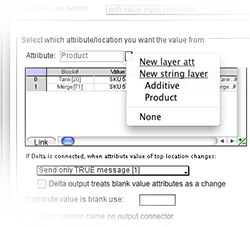 type of product that is modeled as a continuous "flow" in a discrete event environment.
type of product that is modeled as a continuous "flow" in a discrete event environment.
Examples of flow include bulk material such as grain or ore, liquids and gases, and product in a high-speed production line. A flow attribute is a quality or characteristic of flow that stays with it as it moves through the model, such as type, product, color, and so forth. Flow attributes provide information about the flow and allow you to organize quantities or volumes of flow into layers. The entire set of attribute values assigned to a particular layer is what distinguishes it from other layers. In other words, all the units of flow in a layer possess the same set of flow attribute values.
Flow attribute usage includes:
![]() The flow held in a Tank can be organized into individual, distinct layers. This allows you to control where incoming flow is deposited and which type of outgoing flow next exits.
The flow held in a Tank can be organized into individual, distinct layers. This allows you to control where incoming flow is deposited and which type of outgoing flow next exits.
![]() Flow rates through the Valve block can be calculated based on flow attribute values.
Flow rates through the Valve block can be calculated based on flow attribute values.
![]() Flow can be routed through the Merge and Diverge blocks based on flow attribute values.
Flow can be routed through the Merge and Diverge blocks based on flow attribute values.
![]() Attributes are assigned to the flow by the model builder. They become linked to sections of flow that pass through the blocks, according to settings in the blocks' dialogs.
Attributes are assigned to the flow by the model builder. They become linked to sections of flow that pass through the blocks, according to settings in the blocks' dialogs.
 Excel Add-In
Excel Add-In
The ExtendSim DB Add-In for Excel works with database text files to transfer data between an ExtendSim database and Microsoft Excel.
Excel has become the ubiquitous repository for simulation data and is often used for ad-hoc analysis. However, because of performance and scalability issues, Excel is a less-than-ideal database.
To bridge the gap between Excel as a data repository and the ExtendSim database, we created an Excel Add-In that allowed exported ExtendSim database text files to be imported into Excel for editing, then exported back to ExtendSim.
ExtendSim 9 contains an entirely new version of the Add-In that supports most of the construction and editing features available in ExtendSim. This means that you can completely specify a new ExtendSim database in Excel, including parent/child relationships, cell randomization, named distributions, and more. Afterwards, export the database for use in ExtendSim models.
In addition, the new Add-In leverages the latest Excel features such as ribbon interface, XML-based file format, and 1 million rows/16,000 columns. Plus, database consistency checking is now faster and has expanded capabilities.
 Item Logging
Item Logging
Track items and their states as they move through a simulation. In addition to the existing ExtendSim trace features, the Item Log Manager (ILM) block supports customized data collection and report configuration from within ExtendSim by doing two things:
![]() During the simulation run, the ILM block directs other blocks in the model to collect data on items as they pass through. These "remote" data collecting blocks include History, Activity, Queue, Queue Equation, and Resource Item. Each of these blocks can be remotely instructed to collect specific item property information for the ILM through its "Data Collection" tab.
During the simulation run, the ILM block directs other blocks in the model to collect data on items as they pass through. These "remote" data collecting blocks include History, Activity, Queue, Queue Equation, and Resource Item. Each of these blocks can be remotely instructed to collect specific item property information for the ILM through its "Data Collection" tab.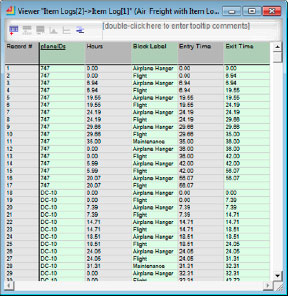
![]() Once the remote blocks have collected the data, the ILM packages it into a report. You can control which types of data are included in the report and the order in which the data appears. This is done on the ILM block's "Configure Log" tab.
Once the remote blocks have collected the data, the ILM packages it into a report. You can control which types of data are included in the report and the order in which the data appears. This is done on the ILM block's "Configure Log" tab.
Once the run is complete, any number of reports can be generated from the data that has been collected in the remote blocks. These reports can be generated after each run either automatically or manually. Any number of ILM blocks can be used in any one model with each ILM block responsible for generating its own report. The ILM also supports generating reports across multiple runs.
This screenshot is an example log of aircraft operations, showing the individual plane ID's and their corresponding entry and exit times through various points in the model.
 Templates Library
Templates Library
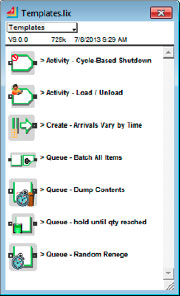 Speed up model building by using pre-built templates for common modeling situations. These templates are actually submodels within hierarchical blocks - constructs created in ExtendSim by combining just a few blocks together.
Speed up model building by using pre-built templates for common modeling situations. These templates are actually submodels within hierarchical blocks - constructs created in ExtendSim by combining just a few blocks together.
ExtendSim's Templates library blocks are similar to standard blocks in that they contain an icon, help, blocks, and animation that can be used directly by the modeler. However, they contain the combined functionality of many blocks. As with any ExtendSim block, simply drag a block from the Templates library into the model and change the parameters to reflect a specific modeling situation.
Template library blocks include:
![]() Activity (cycle-based shutdown)
Activity (cycle-based shutdown)
![]() Activity (load / unload)
Activity (load / unload)
![]() Create (arrivals vary by time)
Create (arrivals vary by time)
![]() Queue (batch all items)
Queue (batch all items)
![]() Queue (dump contents)
Queue (dump contents)
![]() Queue (hold until quantity reached)
Queue (hold until quantity reached)
![]() Queue (random renege)
Queue (random renege)
![]()
![]()
![]()
 Smart Connections
Smart Connections
Intelligent connection line control better automates the modeling process when moving blocks around. Imagine That has developed a series of features collectively called "smart connections" that allow the modeler to quickly and easily modify models by moving blocks into strategic positions.
![]() Bump Connect
Bump Connect
When a block from the Item or Rate library is placed in the model and its input connector is placed on an output connector of the same type, ExtendSim will automatically connect the blocks spaces them evenly, and aligns the connectors.
![]() Insert Over Connection
Insert Over Connection
Drop a block onto an existing connection line so either the block's input or the output connector is on that connection line. Smart connections will increase the spacing between the existing blocks and insert the new block inline between two existing blocks.
![]() Connection Routing
Connection Routing
If a block is moved, ExtendSim will reroute the connection lines so they will not cross over the icon of the block.
![]()
![]()
![]()
 New Menu Commands
New Menu Commands
![]() Read/Write Index Checking (Database menu)
Read/Write Index Checking (Database menu)
Gives an error message when a model tries to read or write data using a non-existent or incorrect database address or index. Useful for debugging block code that interfaces with the database.
![]() Smart Connections (Edit menu>Options>Model tab)
Smart Connections (Edit menu>Options>Model tab)
If unchecked, turns off the intelligent connection line control discussed in Smart Connections.
![]() Statistics (DB) Report (Run menu>Report Type>Statistics DB)
Statistics (DB) Report (Run menu>Report Type>Statistics DB)
Automatically stores and organizes statistical data from each simulation run in an ExtendSim database as discussed in Statistics (DB) Report.
![]()
![]()
![]()
![]()
 Other New Blocks
Other New Blocks
Get(R) and Set(R)
![]() Both the Get(R) and Set(R) blocks support the Rate library's new flow attributes feature.
Both the Get(R) and Set(R) blocks support the Rate library's new flow attributes feature.
![]() The Set(R) block is for setting value or string flow attributes.
The Set(R) block is for setting value or string flow attributes.
The Get(R) block displays either multiple flow attributes from one location or one flow attribute from multiple locations.
Meter block
![]() Provides more flexibility and features than the Meter control (Model>Controls>Meter). For example, the color and pattern of the indicator change when the current value has reached specified high and low values. Use the Meter block as a progress bar or to animate a hierarchical block.
Provides more flexibility and features than the Meter control (Model>Controls>Meter). For example, the color and pattern of the indicator change when the current value has reached specified high and low values. Use the Meter block as a progress bar or to animate a hierarchical block.
 Other New Features Added in ExtendSim 9
Other New Features Added in ExtendSim 9
Equation-based blocks
![]() New input and output variables in equation-based blocks.
New input and output variables in equation-based blocks.
![]() Options added in equation-based blocks that provide more control as to when the equation executes.
Options added in equation-based blocks that provide more control as to when the equation executes.
Data import
New options for importing a named range of data from Excel.
Interval statistics
Record the mean, variance, confidence interval, and standard deviation at specific intervals during the simulation using interval statistics.
Quantile statistics
Can now be calculated within ExtendSim.
Multi-component failure modeling
New options are available for multi-component failure modeling
Functions & message handlers
There are a number of new functions and message handlers.
UI and Block Enhancements
 String Attributes
String Attributes
![]() If a change is made to the value of a string attribute, all the blocks that were referencing the old attribute value will now reference the new value.
If a change is made to the value of a string attribute, all the blocks that were referencing the old attribute value will now reference the new value.
![]() If the index for the value of a string attribute changes (the order of the values for the string attribute change), all the blocks that were referencing that value will be alerted to the change in location.
If the index for the value of a string attribute changes (the order of the values for the string attribute change), all the blocks that were referencing that value will be alerted to the change in location.
![]() Changes to string attribute values defined in the database are now error checked at the beginning of the run. This provides more freedom to manipulate databases without having to worry about losing critical pieces of information.
Changes to string attribute values defined in the database are now error checked at the beginning of the run. This provides more freedom to manipulate databases without having to worry about losing critical pieces of information.
![]() A new string attribute interface in the Executive block allows modelers to make global changes to string values that are referenced in other blocks in the model.
A new string attribute interface in the Executive block allows modelers to make global changes to string values that are referenced in other blocks in the model.
 Speed Improvements
Speed Improvements
![]() Models with blocks that don't have Simulate messages now execute faster.
Models with blocks that don't have Simulate messages now execute faster.
![]() Linked list optimization speeds up the performance of Item library queues and the blocks in the Rate library.
Linked list optimization speeds up the performance of Item library queues and the blocks in the Rate library.
 Other Application Enhancements
Other Application Enhancements
ExtendSim Database
Automatically resizes itself based on the number of rows in the imported data.
Variable names
The upper limit of the variable name length for static and local variables has been increased from 63 to 127 characters.
Data tables
Double-clicking the upper left cell of a data table linked to a database goes directly to the database view of that table.
Block Profile
Reports results even if the simulation ends prematurely.
Shift capabilities
ExtendSim's shift capabilities are enhanced and interfaced with additional blocks.
All ExtendSim blocks
Have been enhanced so that fewer blocks are required to build many models.
E3D
Mount nodes on custom 3D objects have been increased from 8 to 20.
 Enhancements to Equation-Based Blocks
Enhancements to Equation-Based Blocks
![]() Additional input and output variables in most blocks.
Additional input and output variables in most blocks.
![]() New checkboxes in the Options tab control the execution of the equation.
New checkboxes in the Options tab control the execution of the equation.
![]() Equation blocks now support static variables that have been declared in include files.
Equation blocks now support static variables that have been declared in include files.
![]() Query Equation (AT and Suite only) has new input variables.
Query Equation (AT and Suite only) has new input variables.
 Value Library Enhancements
Value Library Enhancements
Data Import Export
![]()
![]() Incorporates the new ADO capability.
Incorporates the new ADO capability.
![]() New option to import named range from Excel spreadsheet.
New option to import named range from Excel spreadsheet.
![]() Database field names can be exported to Excel.
Database field names can be exported to Excel.
![]() When importing from Excel, the number of rows in the database automatically adjust.
When importing from Excel, the number of rows in the database automatically adjust.
Mean & Variance
![]()
![]() Collects interval statistics for a specified time period. At the end of the period it reports the calculated statistics, clears the statistics, and begins a new reporting period.
Collects interval statistics for a specified time period. At the end of the period it reports the calculated statistics, clears the statistics, and begins a new reporting period.
![]() Has quantiles so you can see what proportion of the observations fell within an interval.
Has quantiles so you can see what proportion of the observations fell within an interval.
 Item Library Enhancements
Item Library Enhancements
Residence blocks
(Activity, Queue, Queue Equation, and Workstation)
Added variable item input connectors to each block to allow the merging of multiple item streams. This functionality works the same as the Select Item In block's Merge option.
Activity
![]() Two new value inputs:
Two new value inputs:
 PC (Processing Cost) allows users to target different processing costs on different items.
PC (Processing Cost) allows users to target different processing costs on different items.
CPI (Cost Per Item) attaches a unique CPI to each item.
![]() One new value output:
One new value output:
TE (Total Items Exited)
![]() If preempting with items, attributes on the preempting item can be transferred to the preempted item.
If preempting with items, attributes on the preempting item can be transferred to the preempted item.
Executive
![]() Added variable connectors for events.
Added variable connectors for events.
Gate
 Now allows the Shift block to control its behavior.
Now allows the Shift block to control its behavior.
History
![]()
![]() Provides more control over data collection in ExtendSim 9, plus has new options for handling data storage in multi-run scenarios.
Provides more control over data collection in ExtendSim 9, plus has new options for handling data storage in multi-run scenarios.
![]() A checkbox on the Options tab causes data to be stored in a database table at the end of each run.
A checkbox on the Options tab causes data to be stored in a database table at the end of each run.
Query Equation (I)
![]() (AT and Suite only)
(AT and Suite only)
Added targeted querying and two new input variables.
Queue Equation
![]() Gained new input and output variables.
Gained new input and output variables.
Queue Matching
 New "recipe" building and batching capabilities added.
New "recipe" building and batching capabilities added.
Read (I) and Write (I)
 These blocks have new options for querying where to read and write data.
These blocks have new options for querying where to read and write data.
Scenario Manager
(AT and Suite only)
![]() Supports the optimal design of experiments (DOE) method for Minitab 16, a statistical software product from Minitab Inc.
Supports the optimal design of experiments (DOE) method for Minitab 16, a statistical software product from Minitab Inc.
Shift
![]() Allows modelers to display a symbol on block icons if a specific Shift block is used.
Allows modelers to display a symbol on block icons if a specific Shift block is used.
Shutdown
![]()
![]() Separate and independent polices can be specified for both Shift and connector-based scheduled shutdowns.
Separate and independent polices can be specified for both Shift and connector-based scheduled shutdowns.
![]() Off-shift downs (OFD) connector reports the number of shutdowns due to off shifting.
Off-shift downs (OFD) connector reports the number of shutdowns due to off shifting.
![]() Accumulated off-shift downtime (OST) connector reports the amount of time the block has been down due to off shifting.
Accumulated off-shift downtime (OST) connector reports the amount of time the block has been down due to off shifting.
![]() The "multiple components" option has new capabilities:
The "multiple components" option has new capabilities:
The matching feature allows one master failure table to represent multiple failure points in a model.
Summary failure data for each component.
Component state and dependency/independency options.
Block state versus component state reports.
Transport
 Now has an option to prevent items from passing each other when traveling through the block.
Now has an option to prevent items from passing each other when traveling through the block.
 Rate Library Enhancements
Rate Library Enhancements
![]() Characteristics of the flow such as type, product, color, and so forth can be associated with each specified volume of flow.
Characteristics of the flow such as type, product, color, and so forth can be associated with each specified volume of flow.
![]() Two types of flow attributes are supported: layer and string layer.
Two types of flow attributes are supported: layer and string layer.
Contents tab
Each Rate block that holds/provides flow has a Contents tab showing the attribute values of its flow by volume.
 Interchange
Interchange
Now includes a matrix for converting item attributes into flow attributes and vice versa.
![]() Tank
Tank
Provides multiple options for defining how the incoming and outgoing flow should be layered.
New Functions, Message Handlers, and Global Variables
In addition to the functions listed below, include files are useful when creating custom blocks. To see a block's include file, open the block's structure. Then give the menu command Develop>Open Include Files.
 New Modl Functions
New Modl Functions
![]() blockRect
blockRect
![]() clearUndo
clearUndo
![]() DBAddressGetAllIndexes
DBAddressGetAllIndexes
![]() DBDatabaseOpenViewerToTab
DBDatabaseOpenViewerToTab
![]() DBDatabaseTabChangeName
DBDatabaseTabChangeName
![]() DBDatabaseTabDelete
DBDatabaseTabDelete
![]() DBDataGetCurrentSeed
DBDataGetCurrentSeed
![]() DBDataSetCurrentSeed
DBDataSetCurrentSeed
![]() DBFieldExists
DBFieldExists
![]() DBRecordExists
DBRecordExists
![]() dialogRefresh
dialogRefresh
![]() EquationCompileSetStaticArray
EquationCompileSetStaticArray
![]() fileChoose
fileChoose
![]() INetFileImportText
INetFileImportText
![]() INetOpenURL
INetOpenURL
![]() lastSetDialogVariableString
lastSetDialogVariableString
![]() whoInvoked
whoInvoked
![]() WinSetForegroundWindow
WinSetForegroundWindow
![]()
![]()
![]()
![]()
 New Message Handlers and Global Variables
New Message Handlers and Global Variables
![]() ModifyRunParameter
ModifyRunParameter
![]() BlockReceive5-9
BlockReceive5-9
![]() SysGlobal20-29
SysGlobal20-29
![]() SysGlobalInt30-59
SysGlobalInt30-59
![]()
![]()
![]()
![]()
 ADO (ActiveX Data Object) Functions
ADO (ActiveX Data Object) Functions
These functions are used to communicate between ExtendSim and external databases. They are not part of the ExtendSim application but instead are located in the "ADO_DBFunctions v9.h" include file.
ADO_Setup
![]() ADO_Close
ADO_Close
![]() ADO_OpenConnection
ADO_OpenConnection
![]() ADO_GetNumTables
ADO_GetNumTables
![]() ADO_GetTables
ADO_GetTables
![]() ADO_GetTableColumns
ADO_GetTableColumns
![]() ADO_SetTableColumns
ADO_SetTableColumns
![]() ADO_AddRecords
ADO_AddRecords
![]() ADO_SQLServerGetServers
ADO_SQLServerGetServers
![]() ADO_SQLSserverGetDatabases
ADO_SQLSserverGetDatabases
![]() ADO_CreateTable
ADO_CreateTable
![]() ADO_GetFields
ADO_GetFields
![]() ADO_GetNumRows
ADO_GetNumRows
![]() ADO_GetNumFields
ADO_GetNumFields
![]() ADO_ExecuteNonQuery
ADO_ExecuteNonQuery
![]() ADO_ExecuteQuery
ADO_ExecuteQuery
![]() ConvertADODataType
ConvertADODataType
![]() ConvertExtendSimDataType
ConvertExtendSimDataType
![]() DB_FieldGetTypeString
DB_FieldGetTypeString
![]() ADO_CheckCompatableFieldType
ADO_CheckCompatableFieldType
